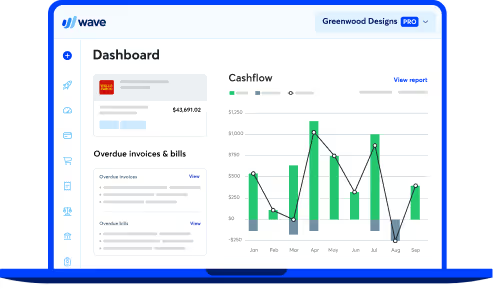
Choosing a business structure: Which one is right for your small business?
Launching a small business is like embarking on an adventure. Before the journey begins, you need to carefully map out the route.
A critical decision you’ll need to make is choosing the right business structure—a choice that can significantly impact your business's legal standing, tax obligations, and overall success.
Once you've chosen a business structure and started operating, changing it can be complicated and expensive. It often involves legal and administrative processes, potentially resulting in complex tax implications and other challenges. Making the right choice from the start minimizes a lot of headaches down the line!
In this article, we'll explore the key considerations in selecting a business structure, offering insights into sole proprietorships, partnerships, limited liability companies (LLCs), and corporations, so you can make the right decision for your business.
What is a business structure?
A business structure refers to the legal and organizational framework through which a business operates and is recognized by the government. It defines how the business is owned, managed, and taxed.
Why are business structures important?
Choosing the right business structure is a critical decision for new business owners, as it influences various aspects of how your business operates. Here are a few things worth considering:
Liability protection
Different structures offer varying levels of personal liability protection. For instance, a sole proprietorship means you're personally liable for everything related to your business, while an LLC or corporation can provide a shield—limiting personal liability for business debts and legal issues.
Partners in a partnership are usually legally liable for debts of your business, including lawsuits, but in certain cases, may have limited liability. The type of entity you choose is crucial for protecting personal assets, like your home and savings.
Tax implications
Each business structure comes with its own tax rules.
Sole proprietors pay tax on their individual returns, and partnerships usually have each partner pay taxes on their agreed upon share of profits.
Corporations and LLCs may offer more flexibility and potential tax benefits, so understanding how your business structure affects your tax obligations can impact your business profits.
There are two main types of US corporations for federal tax return filing purposes. The first one is a C corporation, which can result in double tax. The other an S corporation which may sometimes cut your tax bill by thousands of dollars, in addition to potentially unlocking other benefits.
Management structure
The chosen structure defines how your business is managed and who makes decisions, so understanding the management style that aligns with your vision and goals is crucial!
In a sole proprietorship, the owner will have full control, but limited capital or funding resources.
Partnerships and LLCs may have a mixture of owners and non-owner managers run the business, while corporations have a more formal structure with a board of directors and officers.
Ease of operations
Different structures come with varying degrees of administrative complexity. Sole proprietorships and partnerships are generally easier to set up and maintain, while corporations have more formal requirements. Consider the time and resources you're willing to invest in administrative tasks.
Scalability and growth
The structure you choose should align with your business goals. If you plan to expand and attract investors, a corporation might be more suitable. If flexibility and simplicity are priorities, an LLC could be a better fit.
Legal and regulatory compliance
Each business structure has specific legal and regulatory requirements, so understanding and adhering to these rules is essential to avoid legal issues and penalties. Compliance is easier when you've chosen a structure that aligns with your business activities and goals!
What are the different types of business structures?
Now let’s get into the business structures you can choose from!
Sole proprietorships
A sole proprietorship is a business owned and operated by a single individual. This is the simplest form—it means you and your business are essentially the same. You own and control everything. The owner is personally responsible for all aspects of the business, including its debts and liabilities such as taxes.
Partnerships
A partnership is a business owned by two or more individuals who share the responsibilities, profits, and losses. Partnerships can be general or limited.
In a general partnership, all partners have equal responsibility and are personally liable for the business’s debts. In a limited partnership, some partners have limited involvement and may have limited liability if agreed upon.
LLCs (limited liability companies)
LLCs are flexible forms of businesses that combine elements of a partnership and a corporation. Owners (members) have limited personal liability for business debts, and the business can choose to be taxed as a pass-through entity with profits flowing to each owner’s tax return or as a corporation.
S corporation
An S corporation is a specific type of corporation that, if it meets certain IRS criteria, can avoid double taxation with an approved IRS election. It allows profits and losses to pass through to individual tax returns of members and shareholders while retaining the legal liability protection of the business.
Double taxation in this case refers to having the same profits being taxed once at the corporate level then again on the individual owner level when the same profits are distributed as taxable dividends to the owners. Restrictions on the number and types of shareholders, and certain formalities must be followed or double taxation may occur.
C corporation
A C corporation is a separate legal entity owned by shareholders. The corporation provides limited liability protection for its owners, and it has a formal structure with a board of directors, officers, and shareholders.
C corporations differ from S corporations in terms of being subject to double taxation, flexible ownership limitations, and formal requirements (like board meetings). C corporations are preferred for raising capital from investors, but may be more complex to set up.
What to consider when choosing a business structure
We know, we know—you're eager to bring your ideas to life. But before you dive into the day-to-day operations, you’ll need to weigh your options, and then choose the right business structure.
Unfortunately, the world of business structures can seem like a complex maze, with each path leading to a different set of rules, responsibilities, and implications for your business.
Whether you're launching a small startup or envisioning a larger corporate entity, the structure you choose will shape how you operate, how you're taxed, and the level of personal liability you assume.
From understanding the implications of liability and taxation to grasping the nuances of management styles, we'll walk you through the key factors to consider, ensuring that your chosen structure aligns seamlessly with your business goals.
Risk tolerance
Running a business inherently exposes owners to a higher risk of legal challenges (we like to think the risk is worth the reward, though). Your business has the potential of being liable to each and every customer and supplier it encounters. Understanding the potential for lawsuits is crucial for business owners in selecting an appropriate structure that aligns with their risk tolerance.
For a sole proprietorship, the owner has unlimited personal liability, meaning personal assets such as home, savings, or other investments could be at risk in the event of a lawsuit against the business.
In general partnerships, each partner may be personally responsible for the business's debts and liabilities. This means that if the business is sued, each partner's personal assets are at risk. Limited partners may be protected in certain cases.
An LLC combines aspects of both partnerships and corporations. Members of an LLC generally have limited personal liability, protecting personal assets from business-related lawsuits.
One of the primary advantages of a corporation is that it provides limited liability to its shareholders and is the preferred structure to raise capital. In a C corporation, the personal assets of shareholders are typically protected from business liabilities.
Taxation
Pass-through entities are entities where the business itself doesn't pay income tax; instead, profits and losses are "passed through" to the owners. Pass-through entities often result in simpler tax filings for owners as business profits and losses are reported on their individual tax returns. Another benefit of pass-through entities is the avoidance of double taxation.
Examples of pass-through entities include sole proprietorships, single member (one owner) LLCs, partnerships, and S corporations.
Management structure
Owners may have different visions and goals for the business, leading to conflicts in decision-making. In larger structures, communication channels may become difficult to navigate, making it challenging to ensure all owners are on the same page. Different structures come with various legal and governance requirements, and failure to adhere to these can result in complications.
In a sole proprietorship, the owner has full control over decision-making and operations. The simplicity of this structure is advantageous for solo entrepreneurs, but it limits the input and perspectives available.
Partnerships distribute decision-making among multiple owners. While this can bring diverse skills and ideas, it may also lead to challenges in reaching consensus. Clear partnership agreements are crucial to define roles, responsibilities, and decision-making authority.
Corporations have a formal structure with a board of directors, officers, and shareholders. Shareholders elect the board and officers execute the policies set by the board. Decision-making is often hierarchical, with the board setting strategic direction and officers managing day-to-day operations. Shareholders typically have voting rights on major decisions.
S corporations have a more formal structure. While shareholders elect the board of directors, the day-to-day operations are managed by officers appointed by the board. It comes with restrictions on the number and types of owners since only U.S. resident individuals may own them. This can limit the flexibility in ownership and management, requiring careful consideration of who can be involved in the business.
LLCs offer flexibility in management, allowing for various tax structures. Members can participate actively in operations. However, without clear operating agreements, this flexibility can lead to disputes and challenges in decision-making.
Administrative complexity
Non-corporate structures like sole proprietorships, partnerships, and LLCs typically involve lighter paperwork during the formation process. Startup fees are often more affordable compared to the complexities associated with corporate structures. These structures are designed to be straightforward, making them accessible to entrepreneurs without special expertise.
Larger and more formal partnerships may have elaborate partnership agreements so hiring a legal professional to formalize the agreement is recommended.
Forming an LLC involves more paperwork than sole proprietorships, but it's usually more straightforward than a corporation. LLCs offer a balance between simplicity and flexibility, making them accessible to a wide range of businesses.
Corporations require more extensive paperwork during formation, including articles of incorporation and bylaws. Corporations involve complex legal and tax structures, necessitating the assistance of lawyers and accountants. Strict compliance with state regulations, ongoing reporting, and adherence to corporate formalities are essential for legal and regulatory reasons.
Due to the intricate legal structures of corporations, seeking the advice of a lawyer during formation and for ongoing compliance is highly advisable. Corporations face complex tax obligations, requiring the expertise of accountants to navigate intricate tax laws and filings.
Long-term goals
Long-term business goals are a crucial factor to consider when choosing a business structure, as the chosen entity type can significantly impact the achievement of these goals. Here's a couple things to consider in selecting a business structure.
Scalability and growth
If your long-term vision involves significant growth, attracting investors, or going public, a corporate structure (C corporation or, in some cases, an LLC) may offer the flexibility and scalability needed.
Tax implications for future earnings
Long-term financial goals may involve maximizing profits and managing tax implications. Structures like S corporations and LLCs offer pass-through taxation, providing flexibility in distributing earnings and potentially optimizing taxes.
Asset protection
If protecting personal assets is a long-term priority, especially in industries prone to lawsuits, choosing a structure like an LLC or corporation can provide a strong liability shield for owners.
Succession planning
For businesses with a long-term focus on succession planning or passing ownership to the next generation, a flexible structure like an LLC may offer advantages.
Attracting investors
If attracting external investors is part of the long-term plan, a corporate structure provides the ability to issue different classes of stock and may be more appealing to investors.
If the long-term plan is to seek funding from numerous investors or become a publicly traded company, a C corporation is usually required.
Flexibility in management
Long-term operational goals may involve flexibility in management structures. LLCs offer adaptable management options, allowing alignment with evolving leadership needs.
Regulatory compliance
If your industry is subject to specific regulations, choosing the right structure that aligns with regulatory requirements from the outset can save the aggravation of choosing the wrong type of entity.
Moving ahead with choosing a business structure
Business owners should carefully consider factors, like long term goals, risk tolerance, tax implications and other compliance requirements, and management structure, when choosing a business structure. While sole proprietorships and partnerships expose personal assets to potential lawsuits, corporations and LLCs offer varying degrees of protection.
Choosing a business structure isn’t just a legal formality; it's a strategic decision that should align with your business's long-term vision. Considering scalability, tax implications, asset protection, succession planning, and other long-term goals ensures that the chosen structure becomes a supportive framework for achieving your business's aspirations over time.
(and create unique links with checkouts)
*While subscribed to Wave’s Pro Plan, get 2.9% + $0 (Visa, Mastercard, Discover) and 3.4% + $0 (Amex) per transaction for the first 10 transactions of each month of your subscription, then 2.9% + $0.60 (Visa, Mastercard, Discover) and 3.4% + $0.60 (Amex) per transaction. Discover processing is only available to US customers. See full terms and conditions for the US and Canada. See Wave’s Terms of Service for more information.
The information and tips shared on this blog are meant to be used as learning and personal development tools as you launch, run and grow your business. While a good place to start, these articles should not take the place of personalized advice from professionals. As our lawyers would say: “All content on Wave’s blog is intended for informational purposes only. It should not be considered legal or financial advice.” Additionally, Wave is the legal copyright holder of all materials on the blog, and others cannot re-use or publish it without our written consent.


























